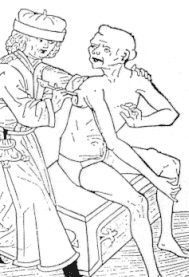Meet the Middle Ages
BackThe bubonic plague, pneumonic plague and septemic plague

There were three kinds of plague: the bubonic plague, the pneumonic plague, which affected the lungs, and the septic plague, which affected the blood. None of those stricken by the pneumonic or septic plague survived. Among those who got the bubonic plague, a few survived.
 The plague often started with shivers, followed by a high fever. Some people got a nosebleed, others started to cough blood. The sick had a nasty smell and a horrible breath. Many had difficulties to breathe. Most got terrible headaches and thought their head would burst. The ill suffered a terrible thirst. No matter how much you drank, you were still thirsty. Some got confused or even insane as the disease affected the brain. Most people died within one or two days. No wonder people felt confused and helpless!
The plague often started with shivers, followed by a high fever. Some people got a nosebleed, others started to cough blood. The sick had a nasty smell and a horrible breath. Many had difficulties to breathe. Most got terrible headaches and thought their head would burst. The ill suffered a terrible thirst. No matter how much you drank, you were still thirsty. Some got confused or even insane as the disease affected the brain. Most people died within one or two days. No wonder people felt confused and helpless!
Those who caught the bubonic plague got apple-sized boils in their armpits, in their groins or on their necks. About half of those who were ill died within 24 hours. If they survived as long as that, one could open the boils to let the pus out. The sick person then had a small chance of survival.
The pneumonic plague was much worse. No one survived it. The sick coughed blood, got bad headaches, were extremely thirsty and died within a few days.
The septic plague was just as deadly. Dark spots appeared all over the bodies of those affected, caused by massive bleedings under the skin. This is why the disease was known as the Black Death.
The plague had many names. Some called it the great death or the black plague. In Sweden, it was called "Digerdöden". "Diger" means great.